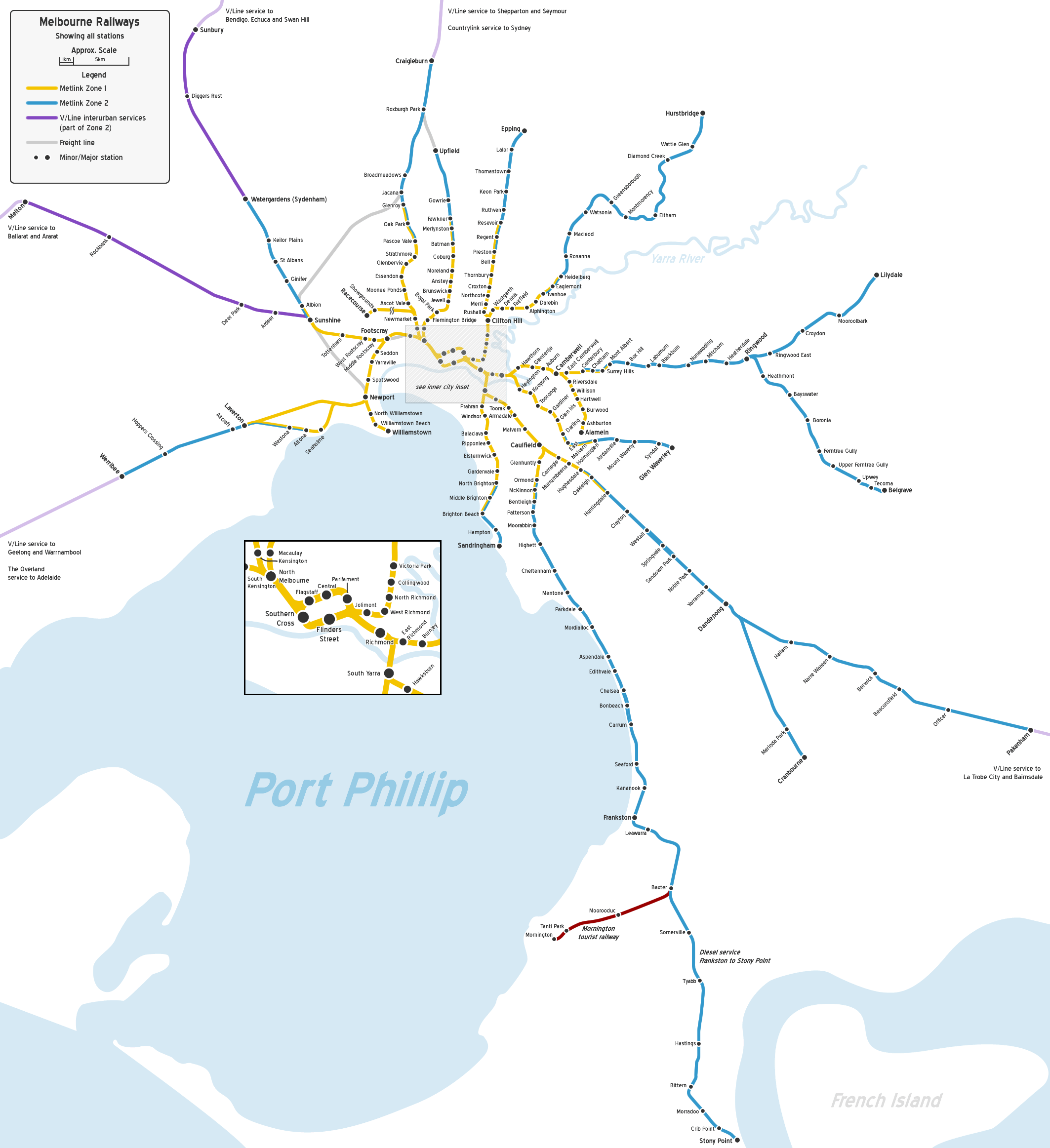- Belgrave railway line, Melbourne
VictorianRailwayLineInfobox
type = mel
name = Belgrave
yearcommenced = 1888 (From Ringwood)
yearcompleted = 1889 to Upper Ferntree Gully; 1900 Narrow Gauge to Belgrave; 1962 Broad Gauge to Belgrave
yearclosed =
fate =
lengthkm = 42.9
stations = 10
tracks = Double track to Ferntree Gully, single track with crossing loops beyond
users =Connex Melbourne
servicepattern =
RollingStock = north
connections = Lilydale line, Gembrook line
formerconnections = Gembrook line at Upper Ferntree Gully

The Belgrave railway line is a
broad gauge electricsuburb an railway inMelbourne ,Australia . It branches from the Lilydale line at Ringwood station. It has eight stations, all of which are inMetcard ticketing Zone 2.Description
The Belgrave line heads south-east from Ringwood, cutting across the Dandenong Creek valley and skirting the foothills of the
Dandenong Ranges to Upper Ferntree Gully. This section has a deep cutting at Heatherdale and at Boronia where the line has been lowered to pass under an adjacent intersection, but otherwise has moderate earthworks and numerouslevel crossing s.From Upper Ferntree Gully the line heads east taking the route of the former
narrow gauge railway to Belgrave, climbing steeply into the southern part of the Dandenong ranges. Earthworks are more extensive here, and all roads are crossed by means of bridges. Beyond Belgrave the narrow gauge line has been restored to working order and runs to the original terminus of Gembrook as thePuffing Billy Railway .Infrastructure
The line is
double track to Ferntree Gully, then single track to Belgrave, with passing loops and island platforms at Upper Ferntree Gully, Upwey, and Belgrave. The line is controlled by automatic block signalling.Intermediate terminating facilities are provided at Bayswater and Upper Ferntree Gully. Bayswater is not normally used for terminating, but is also the location of a repair centre. Stabling facilities are provided at Bayswater, Upper Ferntree Gully, and Belgrave.
History
The line from Ringwood to Upper Ferntree Gully was opened in December 1889. A narrow-gauge RailGauge|30 line was opened from there to Gembrook in December 1900, the second of four experimental narrow-gauge lines built by the
Victorian Railways .In 1921, the narrow-gauge section from Upper Ferntree Gully to Belgrave was converted to automatic signalling, the first such instance on single track in the southern hemisphere Fact|date=February 2007. This section reverted to Staff and Ticket
safeworking in 1930.Electrification of the railway to Upper Ferntree Gully was implemented in November 1925.
Following a landslide in 1953, the narrow-gauge line was formally closed in April 1954, although it was reopened as far as Belgrave for some "farewell specials" and then for the Puffing Billy Preservation Society until again closed in February 1958.
The line was partly duplicated — between Bayswater and Lower Ferntree Gully (now Ferntree Gully) — in February 1957.
The narrow gauge line to Belgrave had been closed so that the line could be rebuilt as part of the suburban electrified system. The new, broad-gauged, electrified, extension opened in February 1962. It initially operated on the Staff and Ticket system, but was converted to automatic signalling in March 1964, with the section from Ferntree Gully to Upper Ferntree Gully being converted the following day.
Ringwood to Bayswater was converted to automatic signalling in June 1974, as was Bayswater to Ferntree Gully in July 1977.In December 1982, Ringwood to Bayswater was duplicated.
Line guide
Bold stations are termini, where some train services terminate; "italic" stations are staffed.
Branches from the Lilydale line at "Ringwood".
See also
*
Narrow gauge lines of the Victorian Railways External links
* [http://www.vicsig.net/index.php?page=infrastructure§ion=lineguide&line=Belgrave Statistics and detailed schematic map] at the [http://www.vicsig.net/ vicsig] enthusiast website
Wikimedia Foundation. 2010.
